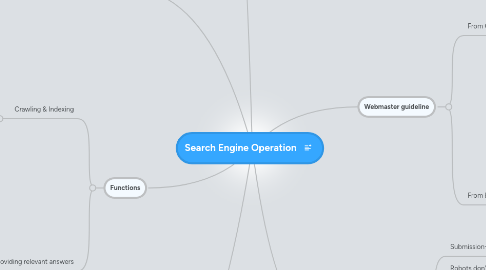
1. Functions
1.1. Crawling & Indexing
1.1.1. Through links, search engines’ automated robots, called “crawlers,” or “spiders” can reach the many billions of interconnected documents.
1.1.2. Once the engines find these pages, they next decipher the code from them and store selected pieces in massive hard drives, to be recalled later when needed for a search query. To accomplish the monumental task of holding billions of pages that can be accessed in a fraction of a second, the search engines have constructed datacenters all over the world.
1.1.3. These monstrous storage facilities hold thousands of machines processing large quantities of information. After all, when a person performs a search at any of the major engines, they demand results instantaneously – even a 1 or 2 second delay can cause dissatisfaction, so the engines work hard to provide answers as fast as possible.
1.2. Providing relevant answers
1.2.1. Currently, the major engines typically interpret importance as popularity – the more popular a site, page or document, the more valuable the information contained therein must be. This assumption has proven fairly successful in practice, as the engines have continued to increase users’ satisfaction by using metrics that interpret popularity.
1.2.2. Popularity and relevance aren’t determined manually. Instead, the engines craft careful, mathematical equations – algorithms – to sort the wheat from the chaff and to then rank the wheat in order of tastiness (or however it is that farmers determine wheat’s value).
1.2.3. These algorithms are often comprised of hundreds of components. In the search marketing field, we often refer to them as “ranking factors” SEOmoz crafted a resource specifically on this subject – Search Engine Ranking Factors.
2. How people interact with search engine?
2.1. Do" Transactional Queries - Action queries such as buy a plane ticket or listen to a song.
2.2. "Know" Informational Queries - When a user seeks information, such as the name of the band or the best restaurant in New York City.
2.3. "Go" Navigation Queries - Search queries that seek a particular online destination, such as Facebook or the homepage of the NFL.
3. How to judge the value of keywords?
3.1. Understanding which websites already rank for your keyword gives you valuable insight into the competition, and also how hard it will be to rank for the given term.
4. Popularity and links
4.1. Link Signal
4.1.1. Search engine
4.1.2. GLobal popularity
4.1.3. Local/Topic-Specific Popularity
4.1.4. Anchor Text
4.1.5. TrustRank
4.1.6. Link Neighborhood
4.1.7. Freshness
4.1.8. Social Sharing
4.2. Link Building
4.2.1. "Natural" Editorial Links
4.2.2. Manual "Outreach" Link Building
4.2.3. Self-Created, Non-Editorial
5. Webmaster guideline
5.1. From Google
5.1.1. Make a site with a clear hierarchy and text links. Every page should be reachable from at least one static text link.
5.1.2. Make pages primarily for users, not for search engines. Don't deceive your users or present different content to search engines than you display to users, which is commonly referred to as cloaking.
5.1.3. Create a useful, information-rich site, and write pages that clearly and accurately describe your content. Make sure that your <title> elements and ALT attributes are descriptive and accurate.
5.1.4. Use keywords to create descriptive, human friendly URLs. Provide one version of a URL to reach a document, using 301 redirects or the rel="canonical" element to address duplicate content.
5.2. From Bing
5.2.1. Ensure a clean, keyword rich URL structure is in place
5.2.2. Make sure content is not buried inside rich media (Adobe Flash Player, JavaScript, Ajax) and verify that rich media doesn't hide links from crawlers.
5.2.3. Create keyword-rich content based on research to match what users are searching for. Produce fresh content regularly.
5.2.4. Don’t put the text that you want indexed inside images. For example, if you want your company name or address to be indexed, make sure it is not displayed inside a company logo.
